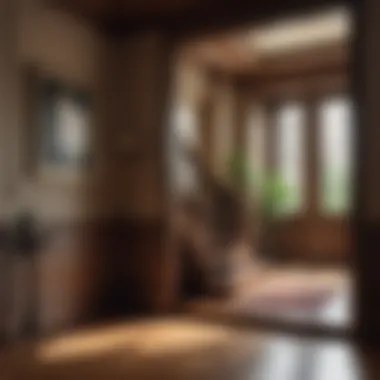Exploring the Significance of Brownstone Buildings


Intro
Brownstone buildings have captured the interest of urban dwellers and architecture enthusiasts alike. These structures stand as symbols of a rich historical heritage, created during a time of significant change in urban development. Their unique architectural elements not only tell stories of the past but also continue to play vital roles in modern city life.
In this article, we will explore the architectural designs of brownstones, their historical relevance, and how they adapt to contemporary lifestyles. We will also discuss their cultural impact and the ongoing efforts in preservation and restoration. By understanding these aspects, you will better appreciate brownstone buildings within the context of their significant evolution.
Exquisite Architectural Designs
Brownstone buildings are known for their elegant designs that embody distinctive characteristics. They often serve as fascinating examples of 19th-century architectural trends, particularly in cities like New York.
Unique Home Features
The charm of brownstones lies in their unique elements:
- Brownstone Facade: The iconic brownstone material is quarried sandstone, which gives these homes their rich color and texture.
- Tall Windows: Large windows enhance natural light, creating bright and welcoming interiors.
- Ornate Detail: Architectural features such as cornices, stoops, and railings showcase elaborate craftsmanship, reflecting the artistic styles of the era.
- Layered Spaces: Multi-story designs typically include a parlor floor, often featuring high ceilings and open layouts, which distinguished them from other row houses.
Historical Significance
Brownstone buildings emerged primarily during the mid-19th century, coinciding with a time of economic growth and urbanization in America. They became the preferred residences for wealthy families. Their styles integrated elements of Greek Revival and Italianate architecture. As cities expanded in population, the practicality of brownstone developments suited the needs of growing communities.
"Brownstones not only represent architectural beauty but also serve as a historical record of urban development and social change in America."
Today, they are not just revered for their aesthetics but also as reminders of a distinct urban landscape. Understanding their historical significance provides insights into social and cultural shifts within the cities they inhabit.
Interior Decorating Tips
For those fortunate enough to live in a brownstone or wishing to incorporate the style into their homes, several interior decorating tips can help maintain the essence of these buildings while adapting to modern sensibilities.
Color Schemes and Trends
While many brownstones feature more traditional hues, modern trends allow homeowners to experiment with colors that complement original features. Consider:
- Earth Tones: Warm colors like terracotta, olive green, and deep browns enhance the natural texture of the brownstone material.
- Contrast: Pairing light and dark shades can accentuate architectural details, creating visual interest without overpowering the space.
Space Optimization Techniques
Brownstones often come with unique layouts. Effective space optimization can create comfortable living areas:
- Functional Furniture: Utilize multipurpose items, such as ottomans with storage, to maximize utility without clutter.
- Open Layouts: Emphasize open spaces by avoiding overly large furniture, allowing flow and movement between rooms.
Preamble to Brownstone Architecture
Brownstone architecture holds a special place in the urban landscape of cities like New York. Its significance is not merely aesthetic; it reflects socio-economic trends, cultural movements, and historical shifts. Understanding this style provides insight into the neighborhoods where these buildings exist and the lives of those who inhabit them. The architectural appeal lies in its intricate facades and warm tones, making brownstones not only residences but also symbols of heritage and community.
Defining Brownstone
Brownstone refers to a type of residential building typically constructed from brown sandstone, a material which gained popularity in the 19th century. The term "brownstone" can also describe the color of the stone used. These buildings are often three to four stories tall, featuring a distinctive stoop at the entrance, which is a defining characteristic. The architecture is primarily recognized in urban settings, where these structures line the streets, creating a distinct atmosphere. Brownstones may vary in size and shape, yet they maintain a certain unity in their materials, proportions, and stylistic elements. The appeal of brownstone lies in its classic look and the warmth of its natural stone, which stand in contrast to more modern, cold materials used in construction today.
Historical Context
The roots of brownstone architecture extend back to the mid-1800s, when rapid urbanization in cities like New York necessitated new housing solutions. As the population surged due to immigration and industrialization, there was an increased demand for affordable yet stylish homes. Brownstone buildings emerged as a practical response to this need.
During this period, brownstone became the preferred material for building due to its availability and durability. Many architects were influenced by the Italianate style, which emphasized ornamentation and symmetry. This resulted in unique design features such as elaborate cornices, decorative window frames, and intricate wrought iron railings. Brownstones became associated with a sense of prestige in the late 19th and early 20th centuries, becoming highly desired properties for middle and upper classes.


The historical significance extends beyond mere construction; brownstones are interwoven with narratives of society, immigration, and transformation in urban settings. They symbolize not just the architectural triumphs of their time, but also the cultural melting pot that thrives in places where these buildings are found. Understanding the historical context of brownstones helps frame their current relevance in urban architecture and preservation efforts.
Origins of Brownstone Buildings
The origins of brownstone buildings are integral to understanding their architectural and cultural significance. These structures emerged prominently in the Nineteenth Century, particularly in urban environments like New York City. Their inception reflects both the historical context of the time and the materials that were readily available. Understanding this foundation is crucial for grasping how brownstones evolved and adapted to the needs of their inhabitants.
Early Development in the Nineteenth Century
The Nineteenth Century marked a period of rapid urbanization in America. As cities grew, so did the demand for housing. Brownstone buildings began to rise in popularity due to their unique aesthetic and practical advantages.
These buildings were primarily constructed between the 1820s and the 1900s, and they often featured three to four stories. Their designs were influenced by various architectural styles, including the Greek Revival and Italianate. Architects like Richard Morris Hunt and the firm of Lamb and Rich played significant roles in popularizing brownstone designs.
"The brownstone building became not just a structure but a symbol of urban living and sophistication."
As various immigrant communities settled in cities, brownstone buildings served as multifamily homes, promoting a sense of community. The wide front stoops and distinctive facades enhanced their charm and encouraged social interaction among residents. This period of development underscores brownstone not just as a style but as a cultural marker, rich with societal implications.
Materials and Construction Techniques
The distinctive appearance of brownstone buildings is largely due to the material used for their construction. Brownstone, a type of brown sandstone, was quarried primarily from places like Haverstraw, New York, and later, from other regions. This material is not only durable but also readily workable for intricate detailing, which has contributed to the enduring appeal of brownstones.
The construction techniques utilized for brownstones combined elements typical of the era with innovative practices that demanded both efficiency and artistry. Key features included:
- Brick and Stone Foundations: These structures typically rested on solid brick or stone foundations, crucial for stability in urban settings.
- Load-Bearing Walls: The heavy brownstone blocks were often arranged in load-bearing walls, which defined the interior space and contributed to the building's overall strength.
- Elaborate Cornices and Details: Many brownstones displayed highly decorative cornices and other architectural details created through skilled craftsmanship. These not only enhanced aesthetics but also showcased the identity of the neighborhood.
Brownstone buildings stand as a testimony to the craftsmanship and thoughtfulness of early American architecture. By understanding their origins, we can appreciate their place in the urban fabric and their lasting impact on American architectural heritage.
Architectural Characteristics
Understanding the architectural characteristics of brownstone buildings is pivotal in appreciating their unique identity. This section sheds light on the distinct features that define such structures, exploring how these elements contribute to both their aesthetic appeal and functional performance. Examining the architectural details offers insight into the craftsmanship of the era in which they were built, as well as their relevance in today's urban landscape.
Facade Elements
The facade of a brownstone is its most recognizable feature and often serves as a visual representation of style and period. Brownstone facades typically showcase a few key elements:
- Brownstone Material: The rich, warm hue of the sandstone, often referred to as "brownstone," provides a unique charm. Its durability and weather resistance make it a preferred choice.
- Window Styles: Tall, narrow windows are common in brownstone designs. They often feature elaborate casings and sometimes arched tops, adding sophistication.
- Entryways: The entrance of a brownstone is usually marked by wide steps leading up to a grand door. These steps might be flanked by decorative railings or ironwork.
- Ornamental Details: Many brownstones feature cornices, friezes, and pilasters, showcasing intricate carvings that reflect the craftsmanship of the builders.
Caring for these facade elements is crucial for preservation. Simple restorations can enhance their charm and maintain property value, contributing to the historic aesthetic of neighborhoods.
Interior Design Styles
The interior of brownstone buildings reflects a blend of various design styles, influenced by the evolving tastes of their inhabitants over the years. Key styles found in brownstone interiors include:
- Victorian Influence: During the late nineteenth century, Victorian design flourished, bringing detailed moldings, heavy drapes, and ornate furnishings to the brownstone interiors.
- Open Floor Plans: Many renovations in contemporary brownstone homes integrate open layouts that create a spacious feel, combining living, dining, and kitchen areas into a cohesive space.
- Contemporary Touches: Modern interior designs might incorporate minimalistic elements, with clean lines and neutral palettes that contrast the traditional architectural features.
This synthesis of styles creates colorful interactions between old and new, often reflective of the owners’ personal tastes.
Common Layouts and Configurations
Brownstone buildings often adhere to specific layouts that are practical for urban living. They typically feature multiple levels, which might include:
- Multi-Story Living: Most brownstones have three to five stories, with living spaces spread across different floors to maximize limited set back.
- Basement or Garden Levels: Many brownstones utilize their lower levels for various purposes, including additional living quarters, storage, or gardens.
- Parlor Floor: A distinctive feature, the parlor floor often serves as a formal living area, with tall ceilings and large windows that open to the outdoors.
These layouts not only optimize space but also enhance the overall living experience. The configurations allow for personal customization, accommodating families and lifestyles in urban environments.


"The architectural elements of brownstones are not simply decorative; they reflect the historical narrative of urban development and residential tastes over the centuries."
In summary, the architectural characteristics of brownstone buildings are integral to their identity and function within urban settings. Each element, whether exterior or interior, tells a story that continues to resonate with those who inhabit or admire these structures.
Cultural Impact of Brownstone Buildings
Brownstone buildings hold a significant place in the cultural landscape of urban America. Their unique architectural style and historic roots resonate deeply with a sense of identity and belonging in cities like New York, Boston, and Philadelphia. Understanding their cultural impact offers insight into the community and social dynamics shaping urban life.
Symbol of Urban Living
Brownstones are often perceived as emblematic of urban living, representing a blend of elegance and accessibility. Their prominent presence on tree-lined streets evokes a feeling of nostalgia and continuity within the fast-paced urban environment. These buildings provide a distinctly urban experience, often situated near vibrant neighborhoods filled with cafes, shops, and parks.
This architectural style has also become a status symbol, providing a tangible connection to the cultural past of American cities. Icons of wealth and community, brownstones often reflect the aspirations of families who choose to live in them. Their charm attracts real estate enthusiasts, making them a coveted piece of urban life for many. Additionally, they serve as a gathering point for diverse communities, fostering social interactions that enrich the cultural fabric of their neighborhoods.
"Brownstones not only house families; they tell stories of heritage, struggle, and triumph along city streets."
Influence on Modern Architecture
The architectural essence of brownstone buildings has influenced modern design trends. As urban spaces evolve, many architects draw inspiration from the classic elements of brownstone architecture, including brick facades, large windows, and well-defined entrances. This influence is visible in the integration of such features in contemporary residential projects, aiming to bring warmth and familiarity to urban dwellings.
Moreover, the iconic staircase leading to a brownstone entrance exemplifies the connection between the private and public spheres. Modern architects often incorporate similar staircases, promoting community engagement and accessibility.
In recent years, the growing interest in sustainability has also led to a revival of brownstone-style designs. Architects now focus on eco-friendly materials and energy-efficient technologies while preserving the aesthetic character of traditional brownstones. This reflects a seamless blend of tradition and innovation, showcasing how the legacy of brownstone buildings continues to shape modern architecture.
Brownstones in Contemporary Urban Life
The significance of brownstones in today's urban landscape cannot be overstated. They represent a unique blend of historical aesthetic and modern functionality. Many people are drawn to these structures not only for their architectural beauty but also for their role in creating vibrant, livable communities in metropolitan areas. This section examines the current market trends surrounding brownstone properties and how they adapt to the needs of contemporary residents.
Current Market Trends
The brownstone market has seen notable fluctuations in recent years, shaped by various economic and social factors. Interest in brownstones remains high due to their charm and historical value. Many buyers seek them as an investment, appreciating their potential for appreciation in a growing market. The following trends highlight the current landscape:
- Rising Property Values: Brownstones generally have maintained or increased their value even during economic downturns. Investors view them as a solid investment option.
- Gentrification Effects: In various neighborhoods, the renovation of brownstones has spurred broader gentrification processes. This can lead to a mix of new residents and long-term community members, resulting in complex social dynamics.
- Demand for Authenticity: Buyers show a preference for properties that retain original architectural details. Modern renovations that respect the historical aspects tend to attract more interest.
In addition, technology plays a role. Real estate platforms that focus on niche markets enhance visibility for brownstones, expanding the pool of prospective buyers.
Adaptations for Modern Living
Brownstones have evolved to meet the demands of today's urban dwellers. While maintaining their historical essence, homeowners often modify their spaces for practicality and comfort. Common adaptations include:
- Open Floor Plans: Traditional layouts have been adjusted to allow for more open spaces, catering to preferences for light and flow.
- Eco-Friendly Modifications: Sustainability has become a priority. Many brownstone owners incorporate energy-efficient systems, from solar panels to updated insulation techniques.
- Smart Home Technology: Modern features are being integrated. Automation for lighting, heating, and security enhances convenience without compromising style.
Brownstones combine historical resonate with contemporary needs, making them attractive in urban spaces.
Furthermore, outdoor spaces play a key role. Private gardens or rooftop decks are increasingly common, providing residents with essential outdoor areas in crowded city environments.
Challenges Faced by Brownstone Owners
Brownstone buildings, with their historical charm and architectural elegance, present owners with many challenges. Understanding these challenges is crucial. It helps potential buyers, current owners, and enthusiasts grasp the complexities involved in maintaining and restoring these structures. This section discusses key elements related to restoration efforts and preservation regulations, allowing for a deeper appreciation of brownstone ownership.
Restoration Efforts
Restoration of brownstone buildings is a labor-intensive and costly endeavor. Owners often face the challenge of balancing the preservation of historical accuracy with modern utility. Key areas of focus during restoration include:


- Facade Restoration: The exterior often bears the brunt of weathering. Techniques to clean, repair, or replace damaged brownstone can vary. Latex or water-based cleaning methods are preferred to avoid further damage.
- Structural Repairs: Many brownstone buildings suffer from issues related to aging, such as foundation problems and water infiltration. Experts recommend thorough inspections to determine the extent of required repairs.
- Interior Updates: While functionality is important, owners usually aim to retain historical features like moldings and fireplaces. This dual priority can complicate renovation plans.
Owning a brownstone means also investing time and resources into understanding the specific needs of the property. Each building may present unique challenges that require tailored solutions.
Preservation Regulations
Preservation regulations play a significant role in brownstone ownership. Many brownstones reside in designated historic districts. Compliance with local laws and regulations becomes essential. These rules often provide guidelines for restoration and renovation efforts. They seek to maintain the building's historic character and integrity.
Key aspects of these preservation regulations include:
- Approval Processes: Owners may need to secure approval from local historical societies or zoning boards before undertaking major renovations. This process can be time-consuming and may involve multiple hearings.
- Material Specifications: Specific materials may be mandated for use in restoration to ensure authenticity. Owners must often source these materials, which can be challenging and add to costs.
- Tax Incentives and Grants: Some regions provide financial incentives for restoration. Owners should investigate opportunities for grants or tax credits that could alleviate the financial burden of preserving their property.
Understanding both restoration efforts and preservation regulations is crucial for brownstone owners. These elements guide the decision-making processes as they make choices about the future of their homes.
"The balance between historical preservation and modern necessity creates a unique dynamic for brownstone owners."
Engagement with these challenges fosters a community spirit. More than just maintaining a property, brownstone owners often find themselves part of a larger narrative in urban landscapes.
The Role of Community in Brownstone Development
The significance of community in the development and upkeep of brownstone buildings cannot be overstated. Neighborhood dynamics play a critical part in shaping the aesthetic, historical, and cultural landscapes of these structures. The interactions among residents, local organizations, and preservation advocates help to maintain the character of brownstone communities while allowing for necessary modern adaptations. Brownstones often serve as more than just homes; they embody the collective identity of a neighborhood, reflecting shared values and a sense of belonging.
Neighborhood Associations
Neighborhood associations are vital in fostering community engagement around brownstone buildings. These organizations act as a bridge between residents and local government, advocating for policies that protect the unique architectural features of brownstones. They often organize meetings to discuss ongoing maintenance issues or potential improvements to the neighborhood.
In addition, these associations can spearhead community preservation efforts, mobilizing resources to restore local brownstones. Many associations also develop guidelines to promote uniformity in renovations, helping maintain the historical charm that many residents cherish. Often, collaboration emerges from these associations, as members share experiences and knowledge about specific restoration practices or challenges.
"The preservation of brownstone buildings is not just about their physical structure; it's about the stories they tell and the communities they represent."
Associations also play a role in producing educational materials to inform residents about proper upkeep and restoration techniques. Workshops may cover topics such as maintaining original facades or understanding zoning regulations. This knowledge-sharing strengthens community ties and ensures collective investment in the appearance and health of brownstone properties.
Community Events and Engagement
Community events serve as another important aspect of brownstone development. These gatherings provide an opportunity for residents to connect and celebrate the history and culture of their neighborhood. Events may include annual tours of historic homes, gardening contests, or fundraisers for local charities related to restoration efforts. Each event reinforces the identity of the community while generating enthusiasm for maintaining brownstone architecture.
Moreover, engagement through events encourages collaboration among diverse groups. For example, homeowners may partner with local artists for public art projects, which can enhance streetscapes typical of brownstone areas. Educational sessions about local history can promote appreciation for the rich narratives associated with these buildings.
Additionally, social media platforms have become tools for further community engagement. Platforms like Facebook and Reddit allow residents to share their experiences and challenges regarding brownstone ownership and preservation. Discussions can lead to organized efforts aimed at connecting volunteers with specific restoration projects. This modern approach complements the traditional community-building efforts, ensuring that the legacy of brownstone architecture is celebrated and preserved for future generations.
Closure: The Future of Brownstone Architecture
As we assess the trajectory of brownstone architecture, we uncover a narrative as rich as the stone itself. These buildings have evolved far beyond their nineteenth-century origins. Their continued relevance is critical to understanding urban identity, culture, and aesthetics today. Brownstones symbolize not just individual homes but a collective heritage within vibrant neighborhoods. How we engage with, restore, and innovate these structures is vital for sustaining their legacy.
Sustaining Heritage in Urban Contexts
Sustaining heritage involves navigating the delicate balance between modernization and the respect for historical significance. Cities must preserve their brownstones while adapting them to contemporary living. This often requires thoughtful restoration practices. Owners and communities alike face challenges in ensuring the aesthetic integrity of their buildings.
- Education: Public awareness about the historical value of brownstones encourages investment in their upkeep.
- Collaboration: Partnerships between city planners, preservationists, and residents can lead to successful outcomes.
Urban policies also play a role. They must protect brownstones from being altered beyond recognition while accommodating the needs of modern inhabitants. Strategies might include zoning laws that favor preservation or financial incentives for restoration projects. This community-centric approach fosters a sense of ownership and responsibility among residents.
Ultimately, it is about creating urban spaces that honor history while embracing modern living.
Innovations in Brownstone Living
Innovations are necessary for brownstone adaptation. These buildings can cater to modern needs without losing their unique charm. Creative solutions abound. Some adaptations include:
- Smart Home Technologies: Integrating modern conveniences, while carefully managing the aesthetic integrity.
- Energy Efficiency: Upgrading heating and cooling systems to be more environmentally friendly, all while maintaining original appearance.
Embracing innovation does not mean erasing tradition. For instance, many brownstone owners are opting for restorations that respect original architecture while incorporating sustainable practices. This dual approach allows for a comforting blend of history and progress.















